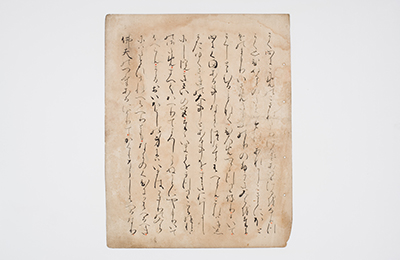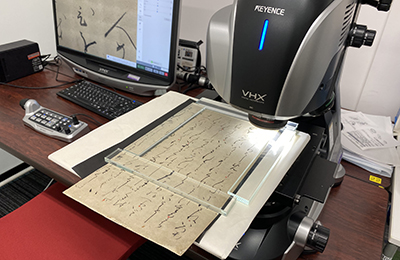Reading The Tale of Genji
In addition to “research on ancient fragments of calligraphy,” which has been the focus of research on the text to date, scientific equipment has been used to “read” The Tale of Genji to enable multifaceted research on the integration of arts and sciences to read and interpret The Tale of Genji. The scientific approach is also applied to establish techniques for dating ancient fragments of calligraphy.
Research on Classical LiteratureCollection of and examination of ancient fragments of calligraphy from the Kamakura Period

Many copies of The Tale of Genji have been made over a long period of time and its is said that the content has been changed with the addition of notes, for example. Collecting materials from older times makes it possible to more accurately reproduce the text written by Murasaki Shikibu in her days. However, many of the classical works of literature such as anthologies, tales and sutras from before the Kamakura Period no longer exist in their original form, and many “ancient fragments of calligraphy” have come down to modern times affixed to hanging scrolls and letters, for example. The university made an early start of collecting ancient fragments of calligraphy from the Kamakura Period and boasts a world-class collection of such fragments now in its possession.
In 2014, the university’s collection of ancient fragments of calligraphy contributed to the restoration of lost parts of “Yoru no Nezame,” or “Wakefulness at Midnight,” a story from the Heian Period. In addition to these achievements, the university conducts investigative research on its collection of materials and materials in the possession of other related research institutes with the aim of acquiring further knowledge from research on the text of The Tale of Genji.
(Photograph: Fujiwara no Tameie: “Usugumo (Wisps of Cloud) Scroll” fragment, The Tale of Genji)
Research on the integration of arts and sciencesObservation of writing paper by using scientific research equipment.

Our aim is to realize multifaceted research integrating arts and sciencess by combining the "reading" research of classical literature with, which has been conducted until now, with scientific techniques (optics and chemistry) such as analysis of the fiber of paper on which classical literature is written using an ultra-high definition microscope and classical literature colors using a fluorophotometer.
The university promotes research using scientific equipment in collaboration with researchers from institutions such as Toyo Bunko (Oriental Library), Ryukoku University and Keio University.